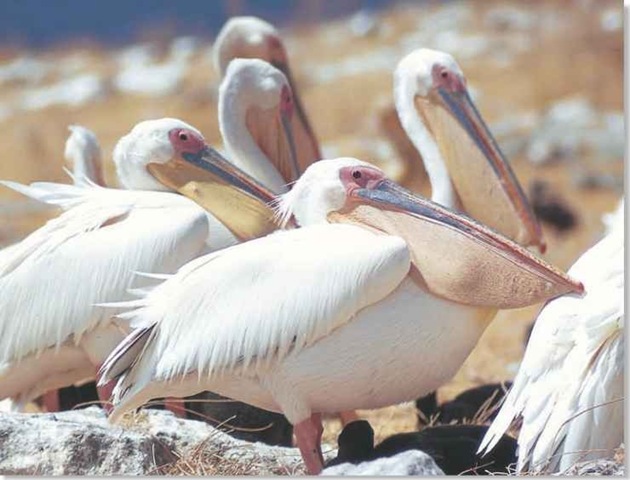ORDER
Pelecaniform.es
FAMILY
Pelecanidae
GENUS & SPECIES
key features
• Assembles in “fishing fleets,” each bird playing its part in a cooperative quest for food
• Birds dip their heads in unison to scoop fish into their huge throat pouches
• In this gregarious species, even the chicks form their own flocks for communal safely
where in the world!
Strongholds are the Rift Valley in Tanzania and the Danube delta in Romania; smaller colonies are widely scattered in Africa, eastern Europe and Asia

Lifecycle
Great white pelicans live in sociable colonies. They also go fishing together, using a perfectly choreographed technique to capture schools of fish in their bill pouches.
Habitat
The pelican favors shallow freshwater lakes, rivers and wetlands, but will only establish colonies where reedbeds, sandbanks or small islands provide protection and allow undisturbed roosting and nesting. An equally essential requirement is that there are rich fishing areas nearby, preferably within 30 miles or so of the colony
The pelican is also found, though less commonly, in saltwater habitats within its range, including the land-locked seas of central Asia.
At home in a crowd The pelican lives in crowded colonies, which can number 40,000 pairs.
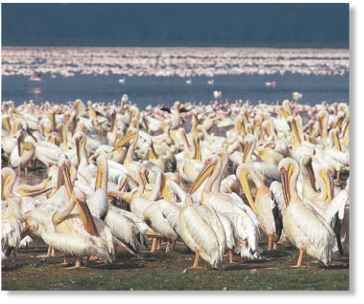
Conservation
Fragmented distribution of the great white pelican reflects a steady decline in population. Like other pelicans, it’s very sensitive to human disturbance, which may cause colonies to desert their eggs. Wetland drainage reduced the number of suitable nesting sites, and the bird has been persecuted by fishermen. Other threats are pollution, disease and flooding.
Food & hunting
fishing fleet
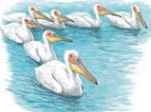
Herding…
Flotillas of pelicans swim in a V-or U-formation to drive schools of fish into shallow water, where they are easy prey.
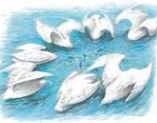
Dipping…
As the birds close in on the school, each pelican submerges its head simultaneously to herd the fish into a “net” of distended bill pouches.
Breeding
Courtship for pelicans is a low-key affair Males display in groups, raising their bills and uttering moo calls. When a male has been chosen by a female, he struts behind her until she decides where to nest, prior to mating.The nest is a heap of vegetation, made by the female from material brought in her mate’s pouch. Both sexes share incubation and rearing.
Young receive regurgitated food for the first two weeks, then take fish from the parents’ pouches. Chicks soon leave the nest to form nurseries or pods of up to a hundred. Podding gives safety in numbers while parents fish. At eight weeks, the young leave to practice fishing before they take flight.
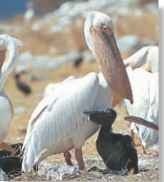
The pelican has developed a technique of fishing in teams with flawless coordination. Parties of up to about 20 birds form a wide arc or a neat V-shape and swim towards the shore, driving fish into the shallows where they become easy prey. They plunge their pouches in perfect synchronization to scoop up the fish, which are swallowed live. Sometimes two arcs of pelicans link up to encircle fish in more open water.
Pelicans are voracious feeders. One large colony studied at Lake Nakuru in Kenya was found to eat 5 tons of fish each day. Such teamwork is not always necessary, however: When fish are large and plentiful, an individual will fish by itself to catch the 2.5 lbs. of food it requires each day.
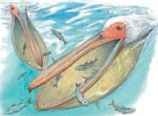
Netting…
Underwater, the huge pouches of the closely bunched pelicans billow to form a continuous barrier, giving the fish little chance of escape.
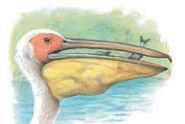
Gulping
A pouchful may have more than 3 gallons of water and several fish. The bird gets rid of the water, then swallows the fish whole.
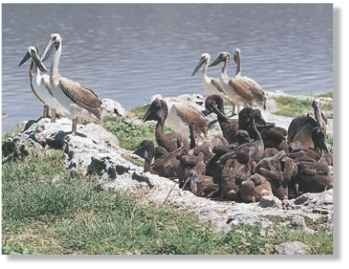
Little brown birds Pelican chicks are clad in dark-brown down.
A Nursery days
The vulnerable chicks are guarded in “pods.”
Behavior
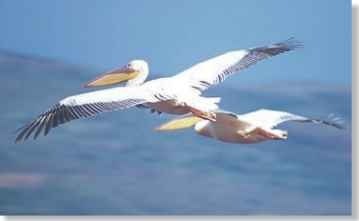
A Air power
Great white pelicans are majestic in flight.
Sociable by nature, the pelican lives communally without the constant bickering of many other gregarious birds. Rival pelicans squabble at court-ng time, but usually the only sound to come from a colony is the deep, restful hum made by the birds’ resonant mooing.
Large flocks of pelicans may gather at traditional roosts, which are also used as daytime resting sites after fishing trips. They may perch in trees, but usually roost on the ground.
The great white pelican is one of the most impressive of all birds in flight, although takeoff is achieved only after a labored, splashing run across the water: Once airborne, flocks assemble into precise V-formations or lines, each pelican timing its wing beats to benefit from the slipstream created by the bird in front of it.
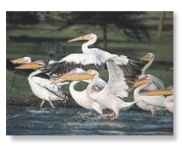
A Birds of a feather Great white pelicans often retire to favorite resting sites after a fishing trip.
Fossils of birds resembling pelicans have been discovered in rocks about 40 million years old, which suggests the pelican family is one of the world’s oldest bird groups.
Two adult pelicans need to catch about 500 lbs. of fish to feed themselves and a single chick during the 10 weeks that the chick remains with them.
Profile
Great White Pelican
The pelican swims strongly and with precise control, dipping its long, flexible neck to scoop a slippery catch in its bizarre pouched bill.

Creature comparisons
The American white pelican looks like a great white pelican, but grows a flattened plate on top of its bill as an adornment in breeding seasons. The brown pelican and the similar Peruvian (or Chilean) pelican are confined to the Americas. They prefer the sea to freshwater and
catch fish by plunge-diving. American white pelican Great white pelican
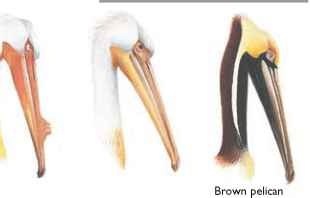
| VITAL | |
| STATISTICS | |
| Weight | 20-26 lbs. |
| Length | 54-66″ |
| ‘WlNGSPAN | 108-132″ |
| Sexual ! Maturity | Probably 3-4 years |
| Breeding 1 Season | Varies with location |
| Number ; of Eggs | 1-3; usually 2 29-36 days |
| Incubation period | |
| Fledging Period | 9-10 weeks |
| Breeding Interval | Annual |
| Typical i Diet | Fish, mostly freshwater species |
| Lifespan | Up to 15 years |
RELATED SPECIES
• There are eight pelican species. The largest is the 6′-long (including its bill) endangered Dalmatian pelican (below); its range overlaps with the great white pelican’s in Europe and Asia. Three others are confined to Africa, Asia and Australia; three more breed in the Americas.

